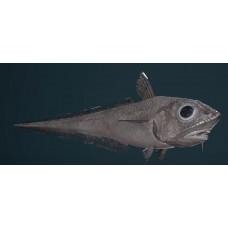Latin name
Macrourus berglax
Other names
Onion-eye grenadier, rough-headed grenadier, rat-tail, onion-eye (English); rat, grenadier berglax (French); Grenadierfisch (German); isgalt (Norwegian); Fabricius langstjert (Swedish). ); bulawik siwy, bulawik szorstki, bulawik szorstkodtowy (Polish); risna laugasporll (Faroese); roughead grenadier, smooth spined rat-tail (Canadian).
Identification
The body is elongated, highest near the first dorsal fin and tapering towards the rear end. Maximum body length is 60-80% of head length. The head is large, broad, 4.2-4.8 times the length of the body. The muzzle is pointed. The distance between the orbits is 24-29% of the length of the head. The mouth is small, inferior. A ridge runs under the eyes from the tip of the snout to the forewing. The body and upper part of the head are covered with large scales. Each scale has several parallel rows of stiff barbs directed towards the caudal part of the body. The barbs are larger in the middle row and smaller at the edges. There are no scales on the lower part of the head, except for 1-3 scales at the corner of the mouth. There is a chin tendril. The eyes are large, oval in shape, the horizontal diameter of the eye is 1/3 of the length of the head. There are 8-10 gill stamens on the first gill arch. Teeth are small. Pyloric appendages about 20. The swim bladder is bifurcated in the anterior part.
Features of fish fins
The first dorsal fin has 9-10 rays and its height exceeds the length of the base. The second dorsal fin is long with 105-124 soft rays. The long anal fin has 113-148 soft rays. Pectoral fins with 18-20 rays are located behind the gill cover, their ends reaching vertically to the beginning of the second dorsal fin. Below the pectoral fins are the pelvic fins with 8 rays.
Fish colouring
Colouring of head and body grey. The ventral side of the body is darker. The edge of the anal fin has a dark border. The first dorsal and pectoral fins are darker than the other fins.
Distribution
In the western Atlantic they are found from Cape Cod to Nova Scotia, northeastern Newfoundland and Labrador and further east to Davis Strait, the Baffin Sea and western Greenland. In the eastern Atlantic they are found off Iceland, the Faroe Islands, Norway and further north to eastern Greenland and Svalbard. In the Barents Sea, the range extends to the coast of Murmansk.
Habitat
Deep-water benthopelagic fish. Inhabits on the continental shelf and on the continental slope on soft substrate set depth from 100 to 2,700 m, mainly at depths from 300 to 1,200m. It occurs at temperatures from -0.5 to 5.4 °C, preferred temperatures from 1 to 4 ° C.
Size
The maximum length is 110 cm. The body weight reaches 4-5 kg. For fish up to 50 cm, the ratio of males to females is about 1:1, but for larger fish the females are much larger.
Behavior
They live near continental slopes. Immature fish fatten on the shelves. They rarely ascend to the middle layers of water.
Food and feeding habits
It feeds on benthic and bottom-dwelling organisms. The diet includes more than 30 taxa of animal organisms: shrimps, clams, brittle stars, polychaete worms, amphipods, sea cucumbers, crabs, squid, jellyfish and fish. Small juveniles feed mainly on bottom-dwelling organisms: small clams, starfish and polychaete. Larger individuals move on to feeding on mobile benthopelagic organisms such as fish, squid and shrimp.
Reproduction
Spawning is very extensive and takes place at great depths. According to different information, the average fecundity is 14.6-25 thousand eggs. The diameter of mature eggs is 3.4-3.85, with an average of 3.62 mm. Judging by the presence of groups of eggs of different sizes, spawning is batch spawning. Eggs have a fat droplet and appear to be bathypelagic. Larvae hatched from the eggs have elongated fin rays, remain in the water column for long periods and are carried long distances by currents, helping to maintain the range of the species.
Fishing
It has tender meat without a fishy taste, low in calories and high in protein. Roughhead grenadier is usually caught with cod and sea bass and is not fished separately.
| Classification | |
| Phylum | Chordata |
| Class | Actinopterygii |
| Squad | Gadiformes |
| Family | Macrouridae |
| Genus | Macrourus |
| Species | M. berglax |
| Features | |
| Conservation status | No information |
| Habitat | Pelagic |
| Life span, years | No information |
| Maximum body weight, kg | 5 |
| Maximum length, cm | 110 |
| Sailing speed, m/s | No information |
| Threat to people | Edible |
| Way of eating | Predator |
Roughhead grenadier
Tags: roughhead grenadier

